My brother in law is staying with us for an extended visit, and today we went to have lunch with one of his sons, who lives in upstate New York. It seemed more convenient to meet halfway, and what better place, in this season, than the site of the second most famous Thanksgiving Dinner in the history of the US. I refer, of course, to that dinner which led more or less directly to the Alice’s Restaurant Massacre, five part harmony and all.
For the untutored among you, and they do exist, I refer to Stockbridge, Massachusetts. Sad to say my nephew and his wife had no idea what we were talking about when we said that this time (we have met them there before) we were going to positively locate the fabled restaurant, and make a pilgrimage to the church. Born in the 70s, they had no idea what we were talking about.
The folks in Stockbridge, even in this Thanksgiving season, pay little heed to this piece of their history. The fellow running the bookshop allowed as how he had eaten at Alice’s (the restaurant) but it wasn’t very good. There are Norman Rockwell memorabilia everywhere (Stockbridge was one of the many New England towns where the peripatetic Rockwell resided), but nothing to memorialize, Alice, her restaurant, Arlo, or even Office Obie.
We were not deterred. Well, my wife was deterred, she thought the whole thing was silly, but my brother-in-law and I soldiered on. He had done research in advance, so we knew where to look, more or less.
First order of business: find the restaurant. As you may recall it was around the back about a half mile from the railroad track, which, truth be told, doesn’t really narrow the location down that much. You would think this sign might help:

Not only does it seem fairly clear, but it definitely points around the back of a building our research stated was the very building. Unfortunately, it appears that Theresa’s too is long gone. We went around the back, but no plaque adorned the wall to confirm that we were indeed on hallowed ground. The railroad tracks, being, as you might recall, a good half mile away, were not to be seen, and therefore of no help. There was a posted bill, however, marking the beginning of the garbage walk, which contained some information about Huntington’s Chorea, so we knew we had found it. We concluded that this is the very door, or the successor to the very door, that Arlo would have entered to visit Alice at work:
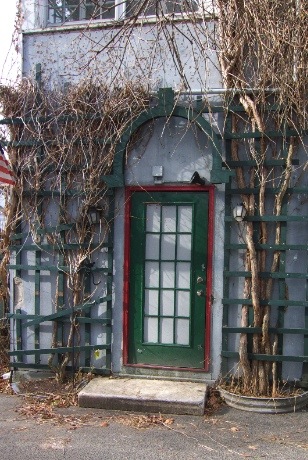
Having ascertained with some certainty that we had located the restaurant we proceeded to the Red Lion Inn, where we had a pre-Thanksgiving Dinner that couldn’t be beat (well, I may be exaggerating there), and proceeded to locate the church in which Alice, Arlo and the rest of the gang resided on that fateful day.
Arlo is now the proud owner of the church. He founded the Guthrie Center, an interfaith spiritual center, which operates from this very quiet corner of Stockbridge (actually Great Barrington). It’s a beautiful New England style church, as shown below.
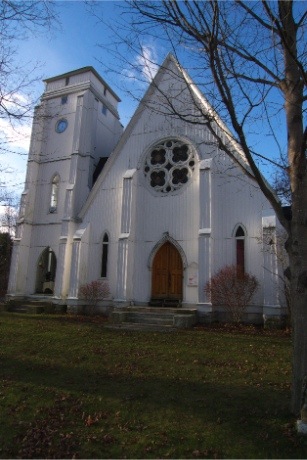
A closer view of the steeple. Yes that’s a peace sign up there.
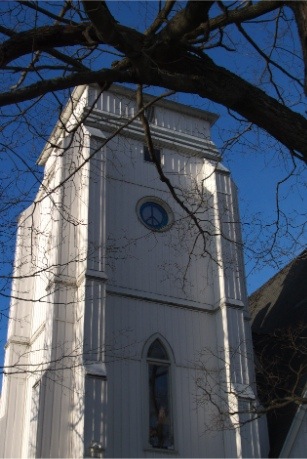
And while Stockbridge may ignore Arlo at Thanksgiving, the Guthrie Center does not ignore Thanksgiving.
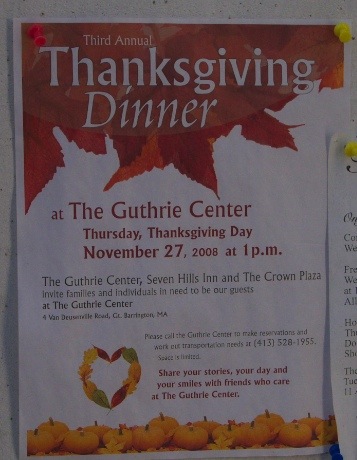
So, our mission was complete. We never made any serious attempt to find the fifteen foot cliff off the side of the side road from which Arlo dumped one of the most famous piles of garbage in history. No doubt no memorial marks the spot.
Stockbridge is not without its other historical locations, and there’s one that stands in stark but silent contrast to the message of peace, and now tolerance, associated with the Massacre. On Main Street, just a half mile from the site of the old restaurant, stands this beautiful old structure.
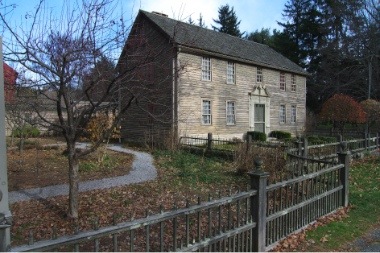
This is the Mission House. It was originally built by a fellow named Sedgwick, who inflicted Christianity on the Indians from this location. He was followed by the famed Jonathan Edwards (like George Bush, a product of Yale), who unsuccessfully attempted to infect the Indians with his rancid brand of Christianity after he had been run out of Northampton by the locals, who couldn’t stomach his insistence that only the saved could take communion. His religious philosophy is perhaps best summed up in the title of his most famous sermon, Sinners in the Hands of an Angry God.
Who are the sinners? Pretty much everyone. Where are they all going? Hell. (Where else?) Why is God angry? Why not?
Edwards was the very intellectual forebear of the decidedly non-intellectual fundamentalists who afflict us today.
Yet, in one of the little ironies that make history so interesting, he was the actual forbear of a very different type of man: Aaron Burr. The purported traitor was Edwards’ grandson. Burr was, in fact, an adventurer, but no traitor. As he pointed out, he was put on trial for the same sort of stuff for which Sam Houston was revered and Crockett and Bowie canonized. More to the point, unlike his narrow minded grandfather, Burr was a true progressive, a true abolitionist, a believer in equality of the races and the sexes, and a friend of the working man. As to religion, he wasn’t much interested.
The arc from grandfather to grandson, in some way, replicates the longer historical arc extending from Puritan to modern New England. Who could have guessed that the New England of Jonathan Edwards would evolve into the New England of today, which boasts the only two states (including our own) that greeted the institution of gay marriage mostly with yawns (take that, California), and can now proudly boast of being the least dogmatically religious (and, I would argue, the most intellectual) section of the country.
One Comment